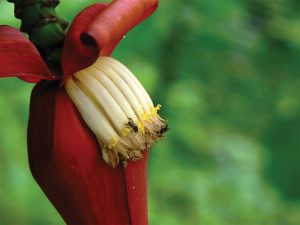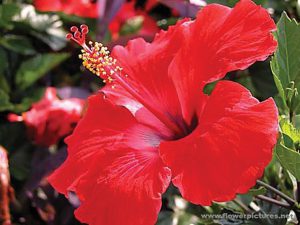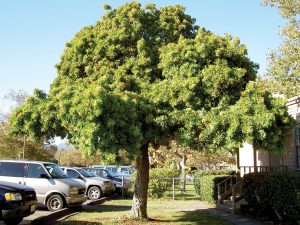By: Connie Krochmal
Beekeepers in warm climates can choose from a number of bee trees. Choices include the native red bay and the common banana as well as flowering trees, such as Chinese hibiscus. These plants are great sources of nectar and pollen for bees.

Banana
Banana (Musa sapientum or Musa x paradisiaca)
About 40 species of banana are grown for food or as ornamentals. They apparently originated in tropical Asia.
Hardiness varies according to the species. Some ornamental types are hardy to zone five. The common banana is root hardy to zone seven, although a mild short freeze can kill the top of the plant. Bee gardeners in cold climates should dig the plants and bring them indoors into an unheated space for the Winter.
The common banana is five to 25 feet in height. Some other species can be almost 40 feet tall. Instead of a trunk, bananas produce a column of compressed leaf sheaths.
The thick stems form a clump. The large, tropical looking, drooping or arching leaves can be eight feet in length. The foliage is sometimes damaged by strong winds.
Blooming sporadically throughout the year, the main flowering period is from Fall through Winter. Opening on a terminal erect or pendant flower spike, the colorful yellow blooms feature vivid purple and red bracts. The blossoms usually hang downward from the top of the plant. The female flowers are located at the base of the flower spikes, while the males emerge near the tips. Flowering usually begins when the plant is about one to 1½ years of age, depending on growing conditions.
Bananas bear fruits in the Lower South. The fruit clumps arise from the flower stalks and turn upwards. Once that occurs, the corresponding stem and foliage begins withering and will be replaced by a new sucker or stem.
Dwarf Cavendish is a highly recommended cultivar. This reaches six to eight feet in height and bears edible, eight-inch-long fruits.
Related species that are cultivated include the Red banana (Musa coccinea), which reaches four to five feet in height. This also bears edible fruits. Rose banana (Musa ornata) grows eight to 10 feet tall.
Most bananas are propagated by root divisions or suckers, which should be planted 1½ feet deep. Although the common banana is seedless, the ornamental species can be grown from seeds. Space the plants about 12 to 15 feet apart, depending on their mature size and the climate. These should be fertilized several times a year in warm areas.
Banana plants prefer full sun or partial shade. They thrive in well drained, porous, rich, moist soils high in organic matter.
These species are excellent nectar plants. They provide a steady and reliable nectar flow over a long period. Good rains and damp soils increase the flow. The fair quality honey varies from light to dark. This can taste slightly astringent, somewhat like tamarind pods. The blossoms also provide lots of pollen.

Chinese hibiscus
Chinese hibiscus (Hibiscus rosa-sinensis)
Also known as China rose, and Chinese hibiscus, this is hardy to zone ten. It was once called shoeflower because Jamaicans used the crushed blossoms to shine shoes. Chinese hibiscus is sometimes grown as a herbaceous perennial in colder areas where it dies to the ground over the Winter and comes back from the roots in the following Spring. Thriving in sub-tropical and tropical regions, it is commonly cultivated in Florida and Hawaii.
Chinese hibiscus is generally a small, dense tree, around eight to 15 feet in height and five feet across. However, it can grow to 30 feet tall under good growing conditions. This erect, fast growing, branching plant features shiny, evergreen, edible foliage. Deep green and toothed, the oval leaves are six inches in length.
The flowers appear from Summer through Winter on new wood. The solitary blossoms are up to eight inches across. They can be red, yellow, pink, salmon, orange, white, or various color combinations. These flowers contain six to nine petals. Double-flowered varieties are unsuitable for bees.
At least a hundred cultivars of Chinese hibiscus are available. The plants tend to naturally hybridize. Often grown as a hedge, this drought tolerant, easy to grow species needs full sun. It grows in most any moist, well drained soil, but prefers a rich one. Fertilize this regularly to keep the plant vigorous. Prune when it quits blooming.
Other cultivated species include Hibiscus coccineus, which is native to Florida and Georgia and hardy in zones seven through 11. Another species known as roselle (Hibiscus sabduriffa) is grown in the Caribbean and Florida for culinary purposes.
Rose-of-Sharon (Hibiscus syriacus) is hardy to zone five. Reaching 15 feet, this commonly grown shrub has smaller flowers than Chinese hibiscus. They’re usually pinkish-blue or pinkish-purple. These open from May through September.
Chinese hibiscus and its relatives are good bee plants. They yield nectar and pollen. Bees are very fond of the blossoms. The abundant nectar is easily accessible to bees. In tropical regions, the plants are major sources of a water-white honey that tends to granulates rapidly.
Ehretia (Ehretia dicksonii)
This is marginally hardy in zone seven and tolerates temperatures slightly below freezing. Introduced from Asia in 1923, it is named for Dionysius Georg Ehret, a renowned German botanical illustrator. Ehretia is generally a small, deciduous, flowering tree when cultivated. In its native homeland, this can reach 50 feet in height. It features a broad, spreading crown. The glossy, elliptic to oval, hairy foliage is eight inches long.
The blooms resemble those of viburnums. They’re in flat terminal clusters, two to four inches wide. The small, scented, light yellow to white, bell-like to tubular blossoms open from Spring into Summer, usually beginning in May.
This bears small drupes, about ½ inch in length. Typically black, they’re sometimes yellow.
In Asia, this species is found in open forests and on moist hillsides up to 7500 feet elevation. It adapts to a range of growing conditions, including drought. Grown from cuttings, this prefers a well drained soil in full sun. Allow the soil to dry out slightly between waterings.
Ehretia and the related species are great sources of nectar and pollen partly because they bloom for a very long period. They yield a moderate honey surplus. The amber to white honey has a characteristic flavor and a sweet aroma.
Flamboyan (Delonix regia)
Also known as flame of the forest, flame tree, royal poinciana, and poinciana, this is considered one of the most beautiful flowering tropical trees. Native to Madagascar, it is widely grown in warm regions, particularly Hawaii and Florida.
About 30 to 40 feet in height, flamboyan is a low growing tree that is much wider than tall. This has feathery, vivid green, doubly compound leaves, which drop before the blossoms open. Up to two feet in length, the fine textured, dense foliage makes this species a good shade tree. The large, flat pods are up to two feet long.
The large, exotic-looking, scarlet-orange or yellow-scarlet blooms open in clusters from the ends of the branches. Although flowering can be somewhat erratic, this is heaviest during the Spring and whenever there is adequate moisture.
Hardy to zone 10, this fast growing plant prefers full sun. Adapted to most soils, flamboyan prefers a moist, sandy loam. Avoid planting this tree near paved areas for the surface roots can damage pavement.
Bees visit the flowers frequently. Flamboyan blossoms, which yield considerable nectar and pollen, are considered beneficial for brood rearing.
Red bay (Persea borbonia)
This is also known as tisswood, laurel-tree, sweet-bay, Florida mahogany, and red bay persea. Hardy to zone seven, red bay is native to the southeastern coastal plain. Its range extends from Delaware through Florida westward to Texas. This typically inhabits swamps, flooded areas, and other spots with standing water.
Usually 20 to 40 feet in height, this tree can reach 50 feet under good growing conditions. A broadleaf evergreen, it features alternate, medium green, leathery, lance-like leaves, two to six inches long. These are sometimes disfigured by a common gall. The fresh and dried leaves are used as a flavoring in gumbo and other Creole foods.
Red bay blossoms open in small panicles. The small, greenish-yellow flowers emerge from late Spring into early Summer.
The fruits are drupes, which come in various colors. Resembling grapes, these ripen in October.
Although the plants typically occur in damp soils, they also adapt well to dry soils. Requiring full sun, red bay is considered an excellent choice for difficult spots where other plants won’t grow. Preferring a sheltered spot, the tree rarely needs routine pruning once it is established. The plants are propagated from seeds and cuttings.
Red bay can bring a heavy nectar flow in some regions. It gives a good honey yield. This is considered a reliable honey plant in certain locations, including Texas.
The very dark honey, usually deep amber, is quite thick and syrup-like. This rarely granulates. At times the flavor can be strong. A fairly good quality honey, it is often used for baking or fed to bees.
Red bay is related to the avocado, which is grown in California and Florida. Avocado is also an excellent honey plant. The honey is similar to that of red bay.
Pepper tree (Schinus spp.)
About 30 species of pepper tree occur worldwide. Members of the sumac family, these broadleaf evergreens vary in size from one species to another. The trees get their common name from the berries, which are sometimes used as spice. Some people are allergic to the fruits and/or pollen. Occasionally, individuals have experienced upset stomachs after consuming the berries.
The compound, alternate leaves, about eight inches long, are composed of two-inch-long, stalkless leaflets in pairs except for the odd terminal one.
The small, inconspicuous blossoms form clusters that can contain hundreds of blooms, which feature five petals.
Two species were widely planted in the Southwest, California, and Florida until it became apparent that they’re quite invasive. These were used along highways, in parks, and home landscapes.
Pepper trees are successful because they adapt to most soils in sun to partial shade. The only serious pests are spider mites and scale. These tolerate heat, drought, and poor soils.

Brazilian Pepper Tree
The most common species in America are the following. Brazilian pepper tree (Schinus terebinthifolius), also known as Florida holly and Christmasberry tree, was widely planted in parts of Florida. It is most common around Palm Beach, Miami, and the southern peninsula. Commonly found along waterways, this particularly loves salt spray. The species also occurs in the Southwest and Hawaii.
Hardy in zones nine through 11, this vigorous, globe-like, dense plant can be a shrub or tree. It is typically 15 to 22 feet tall and ten to 15 feet across. The compound leaves feature three to 13 leaflets.
Male and female flowers occur on separate plants. These emerge in long, feathery, axillary panicles from Spring through Fall with the heaviest blooming occurring in late Summer. The female blossoms are yellow green.
Pepper tree (Schinus molle) occurs in California along the coast and in the southern part of the state as far north as the Bay area.
Hardy in zones eight to 11, this species resembles Brazilian pepper tree, but is slightly taller and wider with drooping, slender shoots. This broad headed tree develops a contorted, thick trunk and wide spreading branches. It features delicate-looking foliage that is smaller and features a greater number of leaflets. In addition, its flower panicles are less dense.
The tiny yellow or white blooms can appear several times a year from Spring through Fall with the main blooming period between May and July.
Both of these species are excellent, reliable, consistent, major honey plants in Florida and California. Yielding lots of nectar, the flowers are much loved by bees. The flow is heaviest when temperatures are elevated. These can bring 50 pounds of honey per colony.
The honey is rather dark, usually some shade of amber. It has a strong, somewhat spicy flavor and spicy aroma. In Florida, the honey is popular among local consumers.
Connie Krochmal is a writer and beekeeper in Black Mountain, North Carolina.






